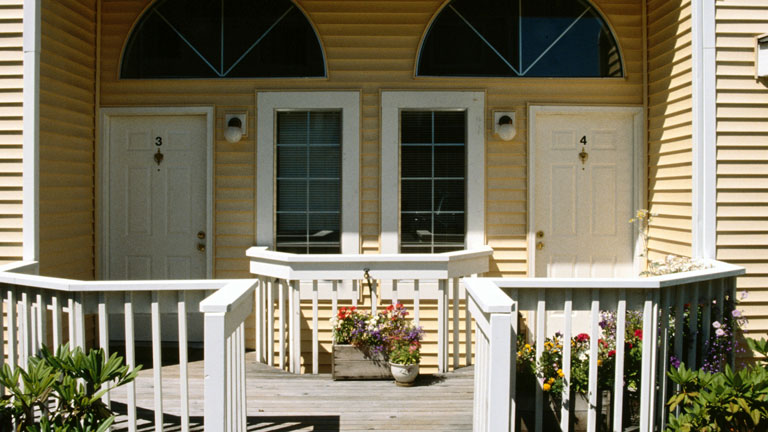
Need to know how much blueprints cost for your new construction project? Use this comprehensive cost guide to get an accurate estimate for your build.
Your home on the range, built for the range


The rambler, or ranch house, was once the most popular style of home in the U.S. before two-story homes rose in popularity in the 1980s.
Its defining characteristics include a low, single-story floor plan and large picture windows.
Newer designs might include multiple stories or walk-out basements.
Depending on where you grew up, you have likely seen a ranch-style house and probably lived in one. One of the most popular styles of single-family homes ever built in the United States, it rose in popularity after World War II following its initial debut in 1930s California. Read on to learn more about this iconic house’s history, its defining characteristics, and the variations that have cropped up nationwide.
Rambler homes, also called ranch-style homes, originated in the United States and date back to the early 20th century. Some of the first examples were found in California and the southwest in the 1930s, with the original most likely designed by architect Cliff May in 1932. The idea was function before form: the rancher-style home, as the name implies, was built to house ranchers who needed simple, low, one-story structures meant to romanticize quiet and solitude and withstand the weather of the plains and mountains—a significant move away from the decorated, Victorian houses and Colonial homes of the east coast.
After World War II, rambler-style houses were mass-produced by several building companies, which, alongside a nationwide fascination with the West, led to this style of home being dominant from 1945 through the 1970s. In fact, by 1950, nine out of 10 new homes were built in the ranch house style.
Several notable characteristics of a ranch house make it stand out from the crowd.
Rambler homes are always low, one-story homes. Larger two-story homes gained popularity in the 1980s. A rambler-style house is an excellent choice for a family with someone who has accessibility issues and might have trouble with stairs. In addition, the layout is typically rectangular or L-shaped.
These homes nearly always have an open floor plan, which allows buyers to designate rooms and spaces as they see fit.

To allow lots of natural light and a connection with nature outside the home, rambler homes have huge, extravagant picture windows. These windows are the most extravagant detail of these homes; the rest of the design is usually relatively minimal. In addition to offering a breathtaking view of the outside, they are an excellent way to showcase a brightly lit and well-decorated Christmas tree or highlight other rustic farmhouse decor in line with the home’s design.
Similar to the reasoning behind the grand picture windows, the ranch house usually will have a large, sliding glass door leading to the backyard area; the idea is to blend the indoor and outdoor spaces.
The homes may look small from the exterior, but they feel much more spacious inside, thanks to their post-and-beam vaulted ceilings.
Like its interior, a ranch home has some noticeable exterior features you can identify. For example, it’s common for ranch homes to have brick or siding exterior finishes. Let’s look at a few other vital characteristics below.
Low-sloped or low-pitched rooflines are standard on ranch-style homes. These rooflines make it easier to maintain a ranch home and are easier to install. A low-pitched roof allows these houses to be heated and cooled more easily.
Similar to their roofline, another common exterior feature of a ranch home is its wide eaves. They’re an aesthetic choice for these homes and help protect them (and their foundation) from snow, rain, and ice. Additionally, they help protect rambler homes from the sun, making them more energy efficient.
While it’s not as common with older ranch-style homes, attached garages are a standard addition to ranch homes. They’re easy to access, convenient for homeowners, and typically cost less than installing a separate garage unit. Also, attached garages help maintain the long look that ranch homes are known for.
Since the original ranch home, several variations have emerged.
The California Ranch is the classic rambler home, originating with Cliff May’s iconic first design. Larger than some other ramblers, the California Ranch has a U- or L-shaped floor plan and might even have a courtyard in the center.
After the war ended and families fled the city's brownstones, the suburbs were born, as was the suburban ranch home. These ramblers are usually built on concrete slabs and are smaller than traditional California Ranch homes to accommodate denser neighborhoods.
A split-level ranch house breaks the classic style by allowing for two, three, or even four levels, usually accessible via a small flight of stairs. These homes became more popular in the 1960s and ‘70s, often featuring dens or basements partially below grade.
Sometimes called a split entry home, this style of rambler also has multiple floors, but only two, unlike the several a split level offers. Walking into a raised ranch, you will typically be greeted by stairs leading up or down to find the rest of the home. The basement will have a full walk-out, compared to the partially below-grade one of the split-level.

There are loads of styles for ranch homes, which means you’ll likely find one that suits your taste. But at its core, there are a few advantages and disadvantages with its layout that you should know. Let’s look at a few of them below.
Ranch-styled homes have some notable benefits for homeowners; here are a few of them:
Everything’s on one floor: A single-story home makes getting around a home quite convenient. There are no stairs to fight with or prevent an eager toddler from climbing. They’re also much more accessible for a person with mobility impairments.
Easy to maintain: Given their low-pitched roofs and single-story design, ranch homes are easier to maintain than multi-story homes.
Open-concept floor plans: Ranch homes are also known for their open floor plans (though not as open as shotgun-style homes), which give more flexibility on how to use the space and make it easy to entertain.
While ranch homes offer homeowners nice benefits, they still have drawbacks worth discussing:
No separate living spaces: While open floor plans are a nice feature, separating the living area and private quarters doesn’t exist. Some ranch-style homes have the primary bedroom off the living room or kitchen. Of course, you can work with a local architect to have some semblance of privacy in your home.
A trade-off in yard space: You'll have less yard space when your home’s square footage is on one level. It doesn’t matter if the yard is one acre or five—the more space your home takes up, the less yard space you’ll have.
Now that you know what a ranch-style house is, is it for you? If you have enough yard space to spare and love how convenient it is to move around this home, you should consider one. If you want to avoid the lack of privacy these homes can typically have, consider a split-level ranch home or talk to an architect for help. Depending on your project scope, architects cost $125 to $250 per hour.
From average costs to expert advice, get all the answers you need to get your job done.

Need to know how much blueprints cost for your new construction project? Use this comprehensive cost guide to get an accurate estimate for your build.

Wondering how much hiring an architect cost? Discover architect prices, cost factors, and money-saving tips to help you plan your home project with confidence.

Get transparent draftsperson cost to hire info, including average prices, cost factors, and tips to help homeowners budget and save on drafting services.

You've heard of landscape designers and landscape architects, but what's the difference? Here's when to hire each pro to bring new life to your landscape.

A split floor plan offers privacy and creates a centralized common living area in your home. Learn if it’s the right choice for your home.

Discover the cost to convert a house to a duplex. Learn about average prices, cost factors, permits, and ways to save for your duplex conversion project.